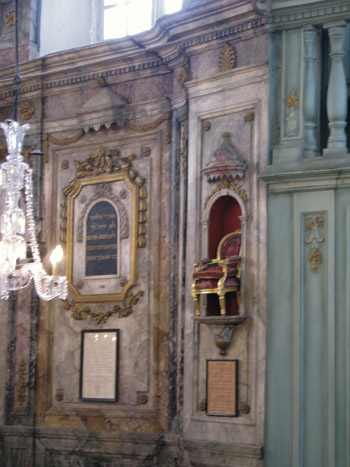The map of France’s Provence region reveals a realm of exciting travel destinations, but it was the picture of a menorah in the centre of an area known as the Vaucluse that drew my attention. Among all the icons of Roman ruins, arches, towers and landmarks, a menorah on the map of southern France initiated a discovery of Jewish heritage going back to the Middle Ages.
Known as the Pope’s Jews, the Arba Kehilot, the four holy communities of Avignon, Cavaillon, Carpentras, and L’Isle-sur-la-Sorgue, developed their own distinctive Jewish traditions and dialect. It was the popes of Avignon who offered Jews exiled from other regions, a safe haven and freedom to worship within the locked confines of their ghettos known as carrières.
This ironic turn of events was largely the result of a schism in the Vatican that prompted Pope Clement V to move the papacy from Rome to Avignon where it remained through seven popes. The awe-inspiring Palace of the Popes, a major UNESCO world heritage site, remains Avignon’s most predominant landmark and oft-visited tourist site.
Picturesque L’Isle-sur-la-Sorgue, with its charming water wheels and famous Sunday antique market, no longer bears evidence of its Jewish past other than the cemetery and the name of the Jewish square (Place de la Juiverie) on the outskirts of town. However, the other communities of the Vaucluse still retain their sites of Jewish importance, primarily centred around their historically significant synagogues.
The Jewish carrière in Avignon used to face the Palace of the Popes, but there is nothing left of the houses once located there. The second carrière, located on Rue Jacob and Place de Jérusalem, does show traces of its Jewish past. It is here that the mid-19th century synagogue, which replaced one from the Middle Ages, can be found. With its neo-classical rotunda set in a square building, the architectural design of the Avignon Synagogue represents a deliberate break from other architectural traditions, featuring unadorned walls, white columns and dark walnut furnishings.
The oldest synagogues still in existence today are found in Cavaillon and Carpentras. Because of overcrowding and general lack of ground space within Cavaillon’s carrière, the synagogue developed vertically, with two prayer rooms, one above the other. The lower level is for women and the upper level for men. A small window, facing the sanctuary and latticed with iron, allowed the women to see the sacred books.
Another distinguishing feature was the rabbi’s pulpit, reached only by a double staircase. The pulpit faced the arc housing the Torah. Despite its humble exterior, the décor of the interior is surprisingly elegant: wood panelling painted grey and trimmed in soft pastel colours, impressive hanging lamps, gold leaf accents, and filigree wrought iron.
The Rue Hébräique in Cavaillon, still retains most of the features of the original carrière, and is easily visited today. The synagogue is located above an arched passageway overlooking the ghetto. Preserved as an historic monument, it is no longer in use, but the synagogue’s basement at street level houses the Musée Judéo-Comtadin in what used to be the matzah bakery. Depicting the community’s history, documents, ritual objects, and the Torah, the museum offers a glimpse into Jewish life in the carrière of Cavaillon.
Another popular tourist attraction in Cavaillon is a lively Monday market opposite the tourism office, where free culinary demonstrations are held using the produce of the region. The preparation and enjoyment of local cuisine is an integral part of the Provençal culture. In keeping with this time-honoured tradition, produce can be bought in the market and taken to a nearby restaurant called La Cuisine du Marché, where it is prepared using local recipes. The restaurant also features a creative Provençal menu and provides cooking lessons. Reservations are recommended.
One of the biggest markets takes place in the town of Carpentras every Friday morning. There is also a Sunday flea market. Carpentras has been designated as Ville d’Art et d’Histoire (City of Art and History), boasting the oldest active synagogue in France, some parts dating from the 1300s. In keeping with mandatory codes and restrictions of the times, the façade of the synagogue is plain and indistinguishable from other buildings, but the interior is elegantly adorned in opulent rococo décor, with columns, false marble ornaments, fancy lighting, and deep rich colours. The Carpentras Synagogue is considerably larger than the one in Cavaillon. The oldest parts (dating from the Middle Ages) are on the ground floor. They include the mikvah, two bakeries, and a room dedicated to Jerusalem in the prayer areas. Recent basement excavations revealed ruins dating to the Roman Empire.
In 2000, the local Jewish community of Carpentras organized a Festival of Jewish Music, featuring Yiddish, Mediterranean and North African music. Information can be obtained from the synagogue or tourism office.
For travellers with a car, driving between towns is quick and easy along well-marked roads, but private taxis are also available for excursions throughout the area. Whether arranging transportation, cooking lessons, visiting the synagogues and museums, or making lunch/dinner reservations, contact the tourism offices for information and assistance. You will find them courteous, knowledgeable, and eager to introduce you to the delights of the region.
Vaucluse – www.provenceguide.com
Avignon – www.avignon-tourisme.com
Carpentras – www.carpentras-ventoux.com
Cavaillon – www.cavaillon-luberon.com
